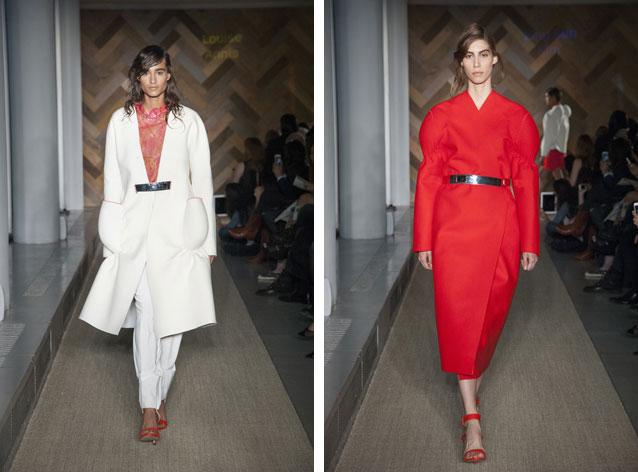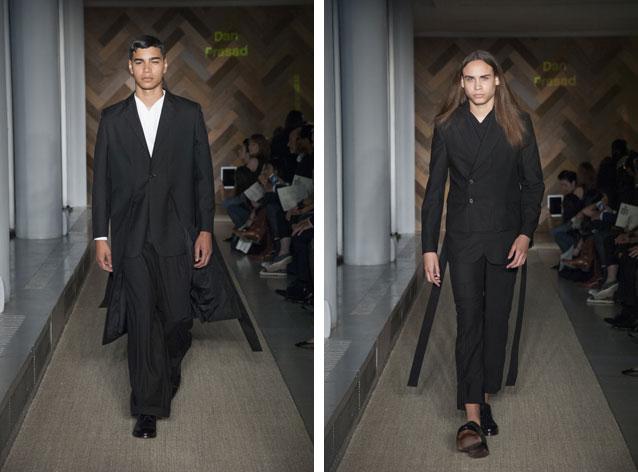Royal College of Art graduate fashion show 2014: our pick of the new names to know

The Royal College of Art, with its emphasis on cross-disciplinary fashion education and small-scale approach to teaching, has earned a reputation for nurturing exceptional talent in its menswear, womenswear and knitwear courses.
We spotted a wealth of potential in this year's thirty fashion graduates, which the college has helped them develop. The collection's individual differences in concept and execution were a clear testament to how research into materials and techniques is stimulated here, but most of all, how the post-graduate environment encourages risk-taking. At the RCA, the experience of designing a final collection is about the personal journey of exploration and creation.
The overarching mood of this season's show? 'There is a lot of fabric manipulation going on,' explains Professor Wendy Dagworthy. 'The students are all inspired by different things, so the collections are very individual, but there's a powerful theme overall. The School of Materials has clearly had an effect. We encourage research into new materials and we allow students to go into workshops in different fields and experiment.'
Professor Dagworthy, one of the founders of London Fashion Week, is retiring from the RCA this year after a 16-year tenure, during which she has cemented the institution's status as a breeding ground for creativity. It makes this year's graduate show particularly momentous.
Pieces of fashion architecture could be found in Katherine Roberts-Wood's womenswear collection, whose rigid silhouettes with undulating details were constructed from harness-like felt structures. Louise Annis cut her coats with curved, reinforced shoulders, offered up new pocket forms, and a bolder saturation point - pairing Pop-hued crimson with magenta.
Big shapes recurred throughout the show, also in softer silhouettes like James Kelly's oversized parkas with feathery surfaces and Eva-Maria Suviste's collection, where silky fabrics on loose-cut garments became bulky through tightly woven frayed panels. Material experimentation is after all the college's calling card. Emma Hardstaff seemed to bring a coherent synthesis of the womenswear theme, crafting her own crackled metallic fabric concoction, composed of foiled fake fur and lace.
A standout menswear collection by Ellen Pederson played with ruching and gathering details, bringing a lightweight feeling of sophistication to masculine shapes. Dan Prasad took the classic men's suit and updated it by removing the collar, but adding fabric elsewhere, in the form of strips and longer under layers that added fluidity.
Receive our daily digest of inspiration, escapism and design stories from around the world direct to your inbox.
As Professor Dagworthy concludes her immensely influential career, we quizz her about the past and present...
W*: What exactly is the role of education in fashion design? What do your students have that self-taught designers may not?
Professor Wendy Dagworthy: A fashion education teaches technical skills, like drawing and creative pattern cutting. If you've don't have a formal education, you will of course have a more open mind, because there are no rules in place. But I do think an education makes you better equipped. You learn how to inform others of what you want. How to communicate through drawing what a pattern cutter has to execute. At the RCA we encourage personal research and through education you learn how to use that research fully.
Fashion has become more present as a career choice. Is there an evolution you've seen in the designers that have been under your tutelage, in how they approach their education?
Yes, they are more aware. Everything around them affects them - music, art exhibitions - it's all connected. They're also more professional. When we started we didn't know what we were doing, there weren't even seasons to work towards! Most colleges now also have professional guidance, so students know their options more: they can start on their own or they can work within the industry. They learn how to behave, put a portfolio together. More and more students now venture into film; we encourage them to find other ways of presenting their work.
As a designer yourself, what have you tried to express?
I looked at travel and different cultures like India and Africa. I was also inspired by workwear. It was an easy, comfortable look, which was about making unusual things work together with attention to detail.
Has it influenced your judgment as a teacher?
Yes, with students I tend to look at details, like what type of buttons to use. But as a teacher the most important thing you try to nurture is the confidence to believe in yourself. You have to know what's going on around you but you have to keep your individuality. And of course enjoy it.

Roberts-Wood's womenswear collection explores rigid silhouettes with undulating details that were constructed from harness-like felt structures

Fellow 2014 graduate Louise Annis upped the saturation point, pairing Pop-hued crimson with magenta

Annis cut her coats with curved, reinforced shoulders, also offering up new pocket formations

Big shapes recurred throughout the show, exemplified by these voluminous designs by James Kelly

Kelly's oversized parkas were festooned with fly-away feathers

Material experimentation - the college's calling card - is especially evident in the work of Eva-Maria Suviste

Suviste's designs work silky fabrics on loose-cut garments, which become bulky through tightly woven frayed panels

Emma Hardstaff crafted her own crackled metallic fabric concoction, composed of foiled fake fur and lace

Each Hardstaff design has been cocooned in sheer tulle

Ellen Pederson dominated the sportif menswear line-up

Pederson played with ruching and gathering details, bringing a lightweight feeling of sophistication to masculine shapes

Dan Prasad took the classic men's suit and updated it by removing the collar, but adding fabric elsewhere, in the form of strips and longer under layers that added fluidity

2014's exceptional graduate show emphasised the college's cross-disciplinary fashion education. Prasad's pared-back tailoring will surely have Savile Row calling soon...
Siska Lyssens has contributed to Wallpaper* since 2014, covering design in all its forms – from interiors to architecture and fashion. Now living in the U.S. after spending almost a decade in London, the Belgian journalist puts her creative branding cap on for various clients when not contributing to Wallpaper* or T Magazine.
-
 Volvo’s quest for safety has resulted in this new, ultra-legible in-car typeface, Volvo Centum
Volvo’s quest for safety has resulted in this new, ultra-legible in-car typeface, Volvo CentumDalton Maag designs a new sans serif typeface for the Swedish carmaker, Volvo Centum, building on the brand’s strong safety ethos
-
 We asked six creative leaders to tell us their design predictions for the year ahead
We asked six creative leaders to tell us their design predictions for the year aheadWhat will be the trends shaping the design world in 2026? Six creative leaders share their creative predictions for next year, alongside some wise advice: be present, connect, embrace AI
-
 10 watch and jewellery moments that dazzled us in 2025
10 watch and jewellery moments that dazzled us in 2025From unexpected watch collaborations to eclectic materials and offbeat designs, here are the watch and jewellery moments we enjoyed this year